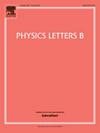Likelihood of a zero in the proton elastic electric form factor
IF 4.3
2区 物理与天体物理
Q1 ASTRONOMY & ASTROPHYSICS
引用次数: 0
Abstract
Working with the 29 available data on the ratio of proton electric and magnetic form factors, , and independent of any model or theory of strong interactions, we use the Schlessinger point method to objectively address the question of whether the ratio possesses a zero and, if so, its location. Our analysis predicts that, with 50% confidence, the data are consistent with the existence of a zero in the ratio on GeV2. The level of confidence increases to 99.9% on GeV2. Significantly, the likelihood that existing data are consistent with the absence of a zero in the ratio on GeV2 is 1/1-million.
求助全文
约1分钟内获得全文
求助全文
来源期刊

Physics Letters B
物理-物理:综合
CiteScore
9.10
自引率
6.80%
发文量
647
审稿时长
3 months
期刊介绍:
Physics Letters B ensures the rapid publication of important new results in particle physics, nuclear physics and cosmology. Specialized editors are responsible for contributions in experimental nuclear physics, theoretical nuclear physics, experimental high-energy physics, theoretical high-energy physics, and astrophysics.
 求助内容:
求助内容: 应助结果提醒方式:
应助结果提醒方式:


